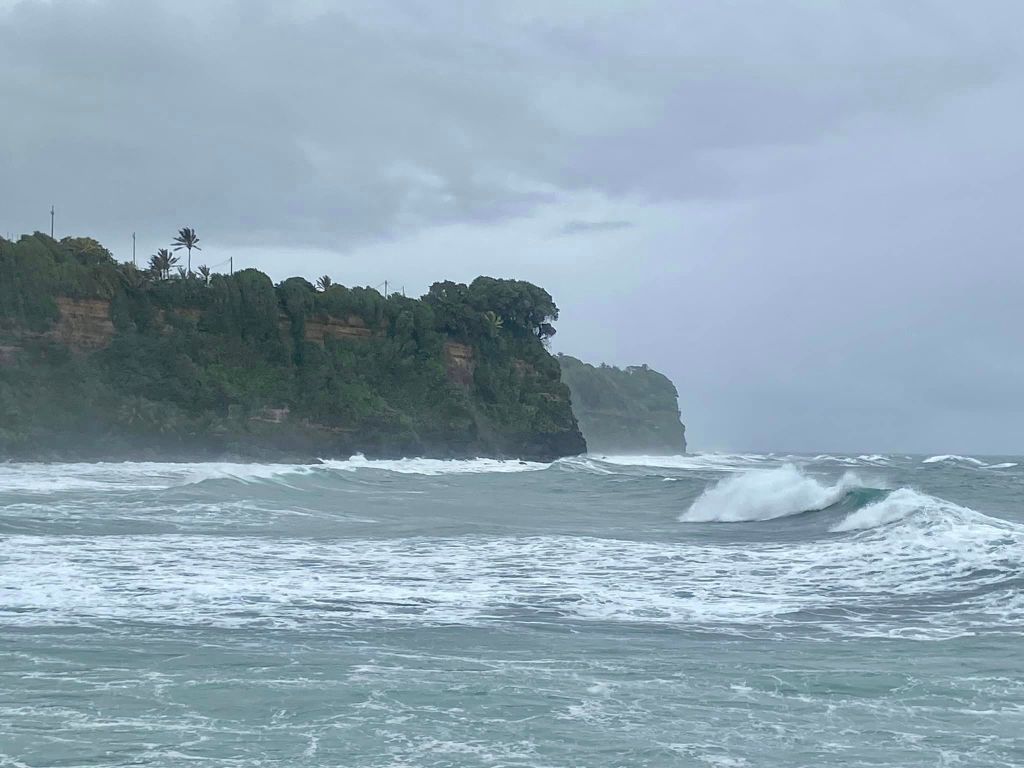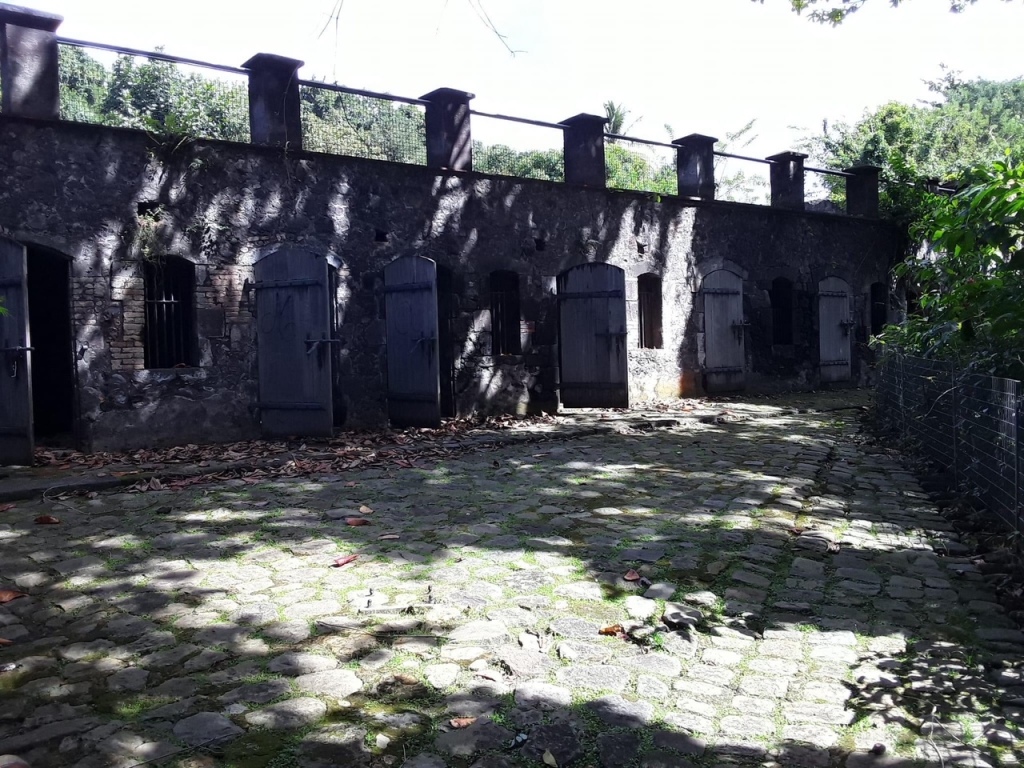Barbados to Martinique (Dec 2023-Jan 2024)
We chose to make landfall after our Atlantic crossing to the Caribbean at Bridgetown, Barbados, as it is the most easterly of the Caribbean islands and we figured that if we didn’t stop there first, we would be unlikely to sail back there against the prevailing winds. While we did manage to see a little of the island, our time there was mostly about catch up and recovery – catching up on sleep, catching up with communications from home, catching up with our sailing buddies, putting the crossing behind us, and doing some repair jobs on the boat.
Slow travel, you might think, provides plenty of time to anticipate new destinations, to adjust your mindset, and to gradually arrive. For us the reality was different. We found that on the Atlantic passage, our longest to date, we existed in some kind of dream world where there were no physical landmarks to provide a sense of progress to our destination – just a line on the screen of our chart plotter and the countdown of the nautical miles which seemed somewhat abstract when every day it looked the same out the window. Then BAM! it seemed like we had suddenly arrived back into the real world which looked, sounded and felt very different to the one we had left behind. It took a while for our heads to catch up to the place where our bodies were!



Phil had noticed a crack in our boom, near the attachment to the mast, just prior to our departure for the crossing, and when our friend told us that he had found a very good welder on Barbados, we decided to take the opportunity to get the boom repaired. We moved Paseafique from the anchorage to a dock we had arranged to use for the day. It was a major job to get the main sail off the boom, and then man-handle the boom onto the dock ready for Irving, the welder. We could not have done this job on our own, and so we were extremely grateful to our friends, Adrian, Al and Dani, for their help. While Irving was working his magic, the team set about sorting out and fixing a couple of other issues. It was late in the afternoon by the time we were getting the boom back onto the boat and re-attaching the mainsail. We definitely needed a rum at the end of that day!


Christmas was coming, and our friend Jan had organised Christmas lunch for a whole bunch of cruisers who had crossed the Atlantic around the same time. But the lunch was on Grenada – 150nm away. We have never had to travel to a different country for Christmas lunch before! Being with our cruising “family” for Christmas was the next best thing to being able to spend it with family in Australia.

Grenada is a veritable garden full of productive trees – cocoa, nutmeg, cinnamon, cloves, papaya, pineapples, mango, bananas, coconuts, and cashews. Therefore we were very surprised at the poor quality, and range, of fruit and vegetables available there – at sometimes eye-watering prices. The tinned fruit that I had stocked up with was looking like a good alternative.



If our defining experience in the Mediterranean had been fascination with the history, then the defining experience of the Eastern Caribbean was delight in the lush, verdant landscapes peppered with magnificent rainfalls, and in the beautiful white sandy beaches of the many bays in which we anchored. After digesting our Christmas lunch, we spent three months island hopping our way north stopping at Carriacou (belongs to Grenada), Union Island, Mayreau, and Bequia (all of which are part of St Vincent and the Grenadines), Martinique, Dominica, Guadeloupe, and St Martins/Sint Maartens. From Grenada to Dominica many miles were sailed to windward (ie., into the wind) in sometimes boisterous conditions. I recall one of our yachtie friends telling us before we left Australia that we would do more windward sailing than you might think on a cruising circumnavigation where you are essentially following the trade winds. We were sometimes frustrated by the erratic wind on the leeward (sheltered) side of some islands and uncomfortable in the swell and headwinds on the windward side. By the time we were sailing from Dominica to Guadeloupe, the wind was more easterly and conditions more favourable for the cruising sailor.
The Carib, or more properly the Kalinago, had widely populated these islands before the Spanish, Dutch, French and British arrived seeking territory that could be exploited for commerce. As a consequence, many of the islands changed hands numerous times, particularly between the French and the British, the indigenous populations were squeezed out, and slaves were brought in to work the sugar and tobacco plantations. Eventually after the slave trade and slavery were abolished, the islands gradually gained independence although some of them still remain as outposts of the colonial powers. Their economies are fragile, mostly reliant on fishing, small scale agriculture and tourism, all of which can be decimated should a hurricane pass through.
The people on the islands we visited were all very friendly, and some were also very relaxed likely due to the pervasion of dope smoking which we could smell pretty much everywhere. It was particularly rife on Dominica, where we heard complaints that the allowance of up to 5 plants for personal consumption had normalised its use to the point that even politicians were smoking it in parliament! There are currently moves to prevent dope smoking in public, possibly to make the streets more tourist friendly. We also noted a very high density of bars on some islands, especially the smaller ones.
Carriacou, Mayreau and Bequia all had beautiful bays and beaches, enjoyed by both locals and tourists alike.



Admiralty Bay on Bequia (part of St Vincent and the Grenadines) was particularly lovely- despite being very much a beachside holiday spot it retained a kind of charm. A community action group is busy there making the island a better place to live and visit. One of their initiatives was restoring a walkway along the edge of bay and strolling along there was just delightful. The walkway eventually leads you to Princess Margaret Beach- so named because Princess Margaret used to come here to swim from nearby Mustique where she owned a property that had been given to her as a wedding present.



Arriving in Martinique was a little bit like stepping back into Europe. It was part of the French West Indies, and although occupied by the British for a period, it was returned to France in 1815. Today it is a Department of France, and one could well be in France. French is the predominate language, bakeries sell fabulous bread and good coffee, supermarkets stock more gourmet items, and there is an air of sophistication. Like other Caribbean islands, it is lush and flowers are everywhere. Here too we enjoyed pretty bays with white beaches.

We hired a car for two days and explored the island, enjoying the lush green landscape and the rugged north coast.




Phil and Adrian got a close-up experience with that lush green landscape when they decided to do a walk up a river bed into the mountains. It turned out to be quite the adventure. First they took a wrong turn and found the ruins of an asylum.

Then they stumbled onto a mansion belonging to the Depaz family. This family were all killed in the 1902 Mount Pelee eruption, except for one member, Victor Depaz who was away in France at the time. He became the sole heir to a large plantation and distillery and subsequently built a large mansion.

After several wrong turns they finally found the overgrown and barely used track to the waterfall. They continued upstream, climbing over rocks and around cliffs, and enjoyed the most fabulous rain forest.
We spent a fascinating time at Saint-Pierre, on the north of the west coast of Martinique. St Pierre was the major shipping port for Martinique and many of the surrounding countries in the 1800’s. It was quite the place with a very busy harbour and thriving businesses -in 1891 it had 5 jewellers, 9 shoemakers, and 10 bakers, among others. The arts and politics were prominent and there was lively debate about the separation of the church from education. No surprise that it was known as the Little Paris of the West Indies.

Then on 23rd April 1902, the volcano Mount Pelee started to grumble and rumble. On May 5th, it exuded a mudflow that set off a tsunami, and on the morning of May 8th, it exploded with a force 40 times stronger than the atomic bomb sending clouds of superheated steam (around 1075 C), volcanic gases, rocks and scalding mud hurtling towards the city.

This event totally flattened the city, sunk many of the ships in the harbour, and almost the entire population of 28,000 people were killed instantly. Eruptions continued until 1907, after which people began returning and the town was re-established.



I was struck by similarities with more disasters that have occurred in more recent times. When Mt Pelee started to rumble, the politicians were quick to re-assure the public that it was safe to remain. The governor of Martinique even brought his family to stay in St Pierre as a sign of reassurance. Once the eruption occurred, the media in Fort-de-France (the capital of Martinique) followed events closely and soon the news was relayed the same day to neighbouring islands and onto the international press. International aid flowed, but sometimes with conditions attached. There was “political manoeuvring”, and a backlash as accusations were made that the loss of life was preventable.

Moving north, we were totally blown away by the sheer natural beauty of Dominica – lush rainforest, crystal clear waterfalls, and bubbling hot springs. The people are friendly and life is simple. We spent about two weeks here, and there is so much to share about it that it deserves it’s own dedicated blog – coming right up.

Great read and photos Lesley and Phil
LikeLike
Thanks for the interesting update!
Alison xx
LikeLike
Love reading about your travels Lesley. Especially as apart from “Death in Paradise” and cricket, I know so little about this part of the world.
LikeLike
Fantastic! Lost for words soaking up your adventure with delight, so very happy that the world is still a good place in so many ways and that you are able to soak it all up and share it so beautifully. Thanks you .Hugs all round. Lindsay
LikeLike
Thanks Lindsay -glad you enjoyed it
LikeLike